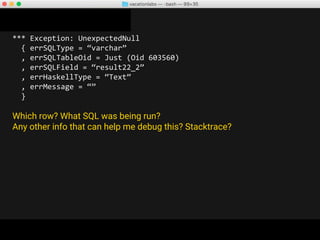

- #BEST HASKELL IDE HOW TO#
- #BEST HASKELL IDE INSTALL#
- #BEST HASKELL IDE DOWNLOAD#
#BEST HASKELL IDE INSTALL#
cabal install or stack install (and make sure ~/.local/bin is on your $PATH). Which provides a ghcide via the haskell.nix infrastructure.įirst install the ghcide binary using stack or cabal, e.g. If your ghc does not match nixpkgs you should try the ghcide-nix repository including in your projects shell.nix.ĭepending on your nixpkgs channel that might not be the newest ghcide, though. You can do so via nix-env -iA haskellPackages.ghcide If the ghc you are using matches the version (or better is) from nixpkgs it‘s easiest to use the ghcide from nixpkgs. Note that you need to compile ghcide with the same ghc as the project you are working on. 
The instructions below are meant for developers interested in setting up ghcide as an LSP server for testing purposes.
#BEST HASKELL IDE DOWNLOAD#
To get it, simply install the Haskell extension in VS Code, or download prebuilt binaries from the haskell-language-server project page. Haskell-language-server is an LSP server built on top of ghcide with additional features and a user friendly deployment model. Ghcide is not an end-user tool, don't use ghcide directly (more about the rationale here). Then if you load A and C into the session but not B then under certain situations youĬan get strange errors about a type coming from two different places.
There is a known issue where if you have three components, such that A depends on B which depends on C. Cross-component features only work if you have loaded at least one file. Projects, it is always advised to specify explicitly how your project partitions. Until tools like cabal and stack provide the right interface to support multi-component You will get much better results currently manually specifying the hie.yaml file. Ghcide supports loading multiple components into the same session so thatįeatures such as go-to definition work across components. Remove redundant imports, replace suggested typos for values and module imports, fill type holes, insert missing type signatures, add suggested ghc extensions Ghcide already exports the following features via the lsp protocol: Featureĭisplay error messages (parse errors, typecheck errors, etc.) and enabled warnings. There are more details about our approach in this blog post. haskell-lsp for sending those messages to a Language Server Protocol (LSP) server. 
hie-hlint and hie-ormolu, to choose which features you want A bunch of plugins that haven't yet been written, e.g.
#BEST HASKELL IDE HOW TO#
this library) for defining how to type check, when to type check, and producing diagnostic messages hie-bios for determining where your files are, what are their dependencies, what extensions are enabled and so on.Our vision is that you should build an IDE by combining: Ghcide - A library for building Haskell IDE tooling Ghcide-bench, ghcide, ghcide-test-preprocessor







 0 kommentar(er)
0 kommentar(er)
